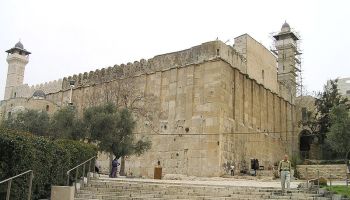Rabbi Mordechai Becher’s Blog – Land of Our Fathers… and Mothers and Grandparents, Uncles, Aunts and Cousins – Lech Lecha 5776
This week’s Torah reading begins with the first commandment G-d ever gave to the first Jew in history – to go to the Land of Israel. The Torah relates that G-d spoke to Abraham, and said, “Go for yourself, from your land, from your relatives and from your father’s house to the land that I will show you. And I will make of you a great nation; I will bless you, and make your name great, and you shall be a blessing.” Abraham, Sarah, their extended family and their retinue all came to Israel, then known as Canaan. They traveled all around the land, engaged in commerce and, of course, in spreading the idea of monotheism. At various times, they lived in the mountains of Bet-El on the west bank of the Jordan; Be’er Sheva in the Negev Desert; and the city of Hebron. G-d promised Abraham that although his descendants would go into exile and be enslaved, ultimately, He would free them, bring them to Israel, and make Israel the eternal homeland of Abraham’s descendants, the Jewish people.
One of the earliest recorded purchases of land was Abraham’s purchase of the Machpelah cave and field in Hebron for the burial of his wife, Sarah. The Torah provides us with the details of his protracted negotiations with the Hittites, Abraham’s insistence on paying “full price,” and his concern that the elders of the Hittites should agree to and witness the purchase because this was the beginning of G-d’s promise turning into reality.
All the Patriarchs, Matriarchs, and the Children of Jacob (the Twelve Tribes), lived in and were buried in Israel. Abraham and Sarah, Jacob and Rebecca, Isaac and Leah were all buried in Hebron, in the cave purchased by Abraham; Rachel was buried on the road to Bethlehem, and even Joseph was buried in the city of Shechem. Although he died in Egypt like his brothers, Joseph specifically ordered that his body be embalmed and not buried, so that the Jews would take it with them at the time of the Exodus, and eventually bury it in Israel.
Following Joshua’s conquest of Israel the Jews lived there as an independent commonwealth and later under a monarchy for 800 years. Judges ruled the people for almost 400 years until the reign of the first king, King Saul. Saul was succeeded by King David, who was followed by his son, Solomon. It was Solomon who built the First Temple in Jerusalem, the capital of Israel. This Temple stood for 410 years until it was destroyed by the Babylonians, who conquered Israel and exiled the Jews to Babylon (modern day, Iraq).
By the Rivers of Babylon…
Although the Jewish people were in exile they did not forget the Land of Israel. Their emotions were prophetically described by King David in Psalm 137:
By the rivers of Babylon, there we sat and also wept when we remembered Zion. On the willows within it we hung our lyres. For there our captors requested the words of song from us, with our lyres [fusion_builder_container hundred_percent=”yes” overflow=”visible”][fusion_builder_row][fusion_builder_column type=”1_1″ background_position=”left top” background_color=”” border_size=”” border_color=”” border_style=”solid” spacing=”yes” background_image=”” background_repeat=”no-repeat” padding=”” margin_top=”0px” margin_bottom=”0px” class=”” id=”” animation_type=”” animation_speed=”0.3″ animation_direction=”left” hide_on_mobile=”no” center_content=”no” min_height=”none”][playing] joyous music. “Sing for us from Zion’s song!” “How can we sing the song of G-d upon alien soil?” If I forget you, O Jerusalem, let my right hand forget its skill. Let my tongue adhere to my palate, if I fail to recall you, if I fail to elevate Jerusalem above my foremost joy…
After seventy years in Babylon, the prophets, Ezra and Nechemiah led many of the exiles back to Israel where they built the Second Temple. The Jewish Commonwealth was renewed and the Temple services were once again performed in Jerusalem. The Jews lived in Israel from the time of their return until the Roman destruction of the Temple and subsequent exile in about 70 CE, about 420 years later. This was a time of great upheaval. The Jewish state experienced invasion by the Greek Seleucids which led to the Maccabean revolt (the Chanukah story); the despotic rule of Herod; the Roman occupation and the various revolts against their rule.
We Shall Not Be Moved
Despite all the invasions, exiles and hardship, two Jewish states existed in Israel during this time, the first lasting for 840 years, the second for 420 years. Even during the long exile that followed the Roman destruction of the Temple a continuous Jewish presence was maintained in the Land of Israel. The land was invaded by Arabs, Crusaders, Saracens, Mongols, Mamluks, Ottoman Turks and the British Empire, but through it all Jews not only remained but produced monumental works of learning and liturgy. Rabbi Judah the Prince, for example, wrote the Mishnah in the north of Israel in 200 CE and the Jerusalem Talmud was edited there in 350 CE. Rabbi Yosef Karo wrote the Code of Jewish Law in Safed in the 16th Century, and the song, Lechah Dodi, was composed and first sung there by Rabbi Shlomo Alkabetz, student of the great Kabbalist of Safed, Rabbi Yitzchak Luriah (The AriZal) in the 16th Century.
During this period many Jews even immigrated to Israel from other lands. The great scholar Nachmanides came from Spain and established a synagogue in Jerusalem in the 13th Century. In the time of Ottoman rule, groups of Hassidim came to Israel on the instruction of their leaders in Europe. The Gaon of Vilna sent many students to settle in Israel, and in the late 19th Century, the Zionist movement brought thousands of people to Israel to establish agricultural settlements and industry there. The attachment of the Jews to their land throughout over 1900 years of exile culminated in the establishment of the modern State of Israel in 1948, now home to over five million Jews from all over the world. Jews of the 21st century take for granted the presence of Jewish communities in Israel. From a historical point of view, however, the return of a people to their land after nineteen centuries of exile (in the case of some 2,500 years of exile), the establishment of an independent Jewish state, and the ingathering of Jews from virtually every country in the world are miraculous and unprecedented events in world history. The building in which I lived in Jerusalem represents a microcosm of the “ingathering of the exiles” that has taken place. Although it contains only fifteen apartments, at one point, the countries of origin of the inhabitants of our building included: Australia, Canada, France, Gibraltar, Greece, Morocco, South Africa, the United Kingdom, the USA… and Israel.
The historian Paul Johnson says the following about the Jewish attachment to Israel:
The Jews are the most tenacious people in history. Hebron is there to prove it…There, in the cave of Machpelah, are the Tombs of the Patriarchs. Hebron reflects the long, tragic history of the Jews and their unrivalled capacity to survive their misfortunes. David was anointed king there… When Jerusalem fell, the Jews were expelled and it was settled by Edom. It was conquered by Greece, then by Rome, converted, plundered by the Zealots, burned by the Romans, occupied in turn by Arabs, Franks and Mamluks. From 1266 the Jews were forbidden to enter the Cave to pray. They were permitted only to ascend seven steps by the side of the eastern wall…
In 1518 there was a fearful Ottoman massacre of the Hebron Jews. But a community of pious scholars was re-established. It maintained a tenuous existence… The Jewish community, never very numerous, was ferociously attacked by the Arabs in 1929. They attacked it again in 1936 and virtually wiped it out. When Israeli soldiers entered Hebron during the Six Day War in 1967, for a generation not one Jew had lived there. But a modest settlement was re-established in 1970…
Hebron is thus an example of Jewish obstinacy over 4,000 years… No race has maintained over so long a period so emotional an attachment to a particular corner of the earth’s surface.[/fusion_builder_column][/fusion_builder_row][/fusion_builder_container]

